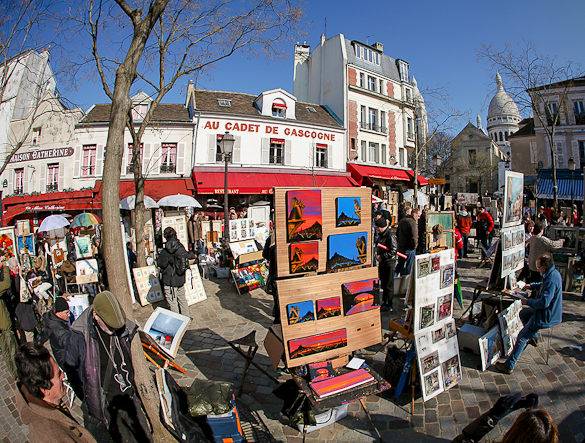
One of the most famous districts in Paris is also one of the most recognizable: Montmartre with its Sacré-Cœur Basilica can be seen rising high above the Paris rooftops from across the city. The 130 meters (426 feet) high hill is famous not only for its remarkable church, but also for its bohemian past. The village within a city once was the home to artists such as Salvadar Dalí, Claude Monet, Pablo Picasso and Vincent van Gogh. The picturesque Paris neighborhood still draws millions of visitors every year. In this article, we’ll highlight some of the top things to see on a daytrip to Montmartre!
Montmartre Hill and the Montmartre Funicular

To start your visit to Montmartre, take the M2 metro to Anvers station in the 9th arrondissement of Paris.
If you walk up the Rue de Steinkerque you’ll see the hill of Montmartre rising up ahead of you. The park at the end of the Rue de Steinkerque is called Square Louise Michel, and its roads wind up to the Sacré Cœur.
However, there’s also an alternative way to get to the top if you’d rather avoid the steep climb. On the left side of the park, an automatic funicular railway carries passengers to the top of the hill.
The trip just takes a minute and a half, and the Montmartre Funicular carries about 2 million passengers every year!
The Sacré Cœur and the Best View of Paris
Once up on the hill, take a minute – or a couple more – to take in the magnificent views of Paris. On the steps in front of the church you’ll see lots people doing just that, as this is one of the most popular touristic spots in Paris. And you can quickly see why: the view of the Parisian rooftops and the many landmarks of the city is unlike anything else in the world. If you can’t get enough of it consider returning after nightfall: the view of the city of light only gets more spectacular after dark. During the day, however, you’ll get the chance to see many street performers doing tricks or playing music for the delight of the crowd. This is also a good time to pick up cheap souvenirs: if you haggle over the price a little you can get pretty good deals!

After you’re done taking in the views, turn the other way to admire the domes of the Sacré Cœur. The majestic church is still relatively young: it was completed in 1914. The travertine stone used for the exterior gives the church its distinctive white appearance. If you’ve got time, it’s definitely worth exploring the interior of the church as well. The church features one of the largest mosaics in the world, and the domes are just as impressive seen from the inside. It’s also possible to climb to the top of the central dome, from which you’ll have an even better view of Paris and also of the Eiffel Tower.
Place du Tertre & Moulin de la Galette

When you exit the church, turn right on Rue Azais. If you follow the road to the right you’ll see a much older church next to the Sacré Cœur, which is the Église Saint-Pierre de Montmartre. Following the road to the left, you’ll come across the Place du Tertre. This little square is the heart of Montmartre, and was home to many famous artists during the bohemian years.

Nowadays, the artistic spirit is still reflected by the many artists who occupy the square every day to draw portraits of tourists. Apart from having your picture drawn, you can also check out the close-by Salvadar Dalí museum or enjoy a delicious crepe at one of the many cafes.
A great alternative for lunch is to walk west along the Rue Norvins to the Moulin de la Galette. This windmill turned restaurant was named after the distinct brown bread called galette that was made here since the 17th century. Over the years, the windmill became a popular spot for Parisians to enjoy great food and wine. Artists such as van Gogh, Pissarro and Renoir have all painted the popular windmill.
Rue Lepic, Café des 2 Moulins & Amélie
After your visit to Moulin de la Galette, walk down the ancient Rue Lepic to soak in a less touristy part of Montmartre. Filled with cafes, galleries and markets you’ll get a sense of what it would feel like to live here as a local.
Continuing the tour, on the corner of Rue Lepic and Rue Cauchois you’ll come across a tiny café called Café des 2 Moulins. Apart from being a cute bistro, this café was also one of the major locations used for the film Amélie. The title character of the 2001 comedy worked as a waitress in the Café des 2 Moulins, where much of the film takes place.
Like what you see? If you can’t get enough of the neighborhood and Paris, consider staying in a Montmartre vacation rental apartment to get to experience it like a true local!
Moulin Rouge

Just three blocks away from the Café des 2 Moulins you’ll find the last stop of our little tour: the famous Moulin Rouge on Boulevard de Clichy. Technically not a part of Montmartre, the Moulin Rouge lies so close to the hill it’s often associated with it. Take a picture in front of the famous windmill, and if you dare you can even check out a show at the place where cancan dancing was invented! The area around Moulin Rouge is also filled with bars and nightclubs, so this is a great place for a night out. For more things to see and do in the area, check out our video tour of Montmartre.
Have you ever visited Montmartre?






Leave a Reply